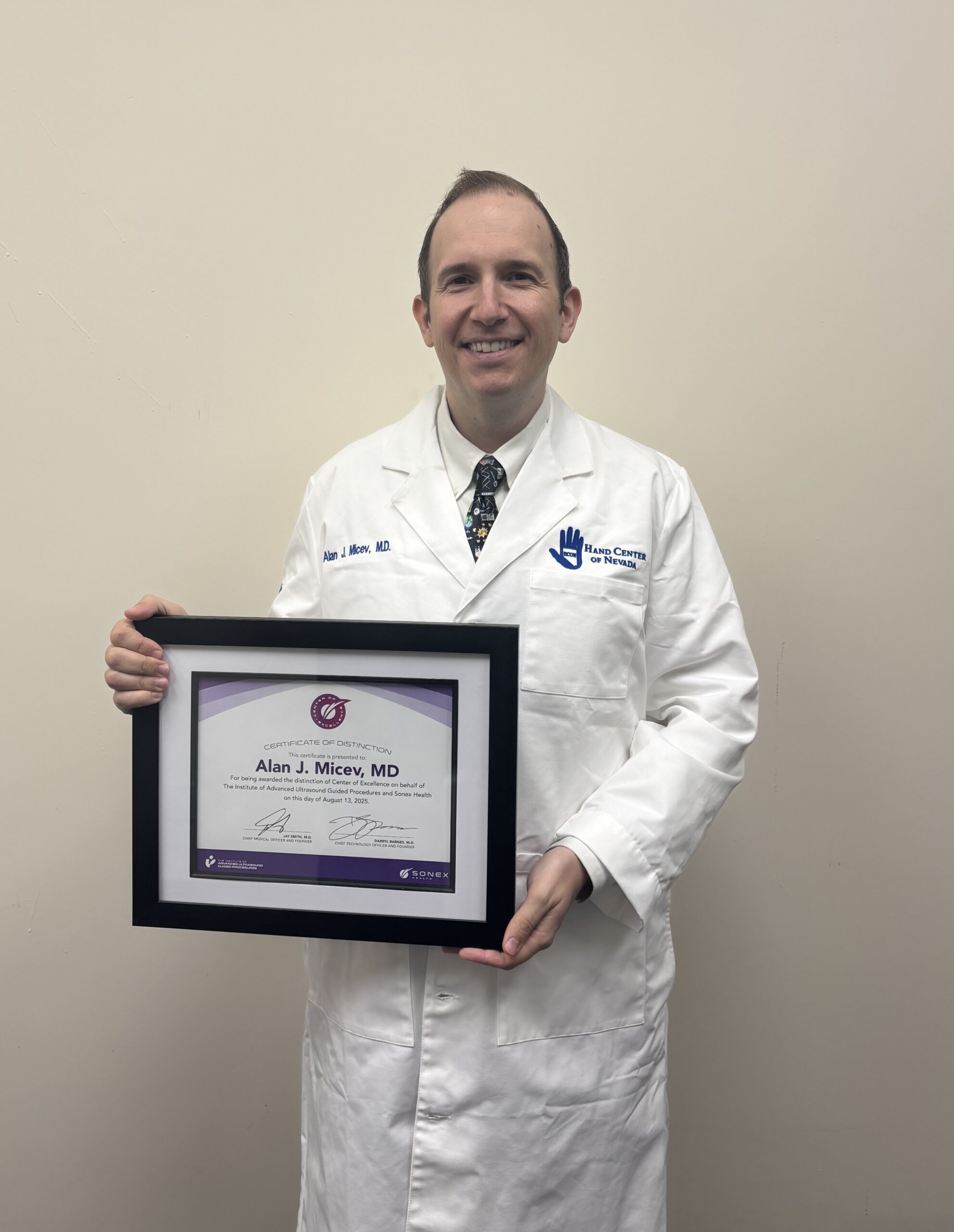
Speeding Patient Recovery and Changing Lives
Quickly returning patients to their lives by providing the most advanced treatments has been the mission driving Dr. Micev’s work at the Hand Center of Nevada in Las Vegas. That goal led him to explore more minimally invasive treatment options for carpal tunnel release (CTR) and trigger finger release (TFR). He started offering CTR with real-time ultrasound guidance (UGCTR) two years ago, and soon after, added TFR with real-time ultrasound guidance (UGTFR) to his practice as well.
The transition from traditional open surgery to minimally invasive ultrasound-guided techniques was monumental for Dr. Micev and life-changing for his patients. “It was a dramatic shift, taking a procedure known for being done in an operating room to performing it in an office setting with very fast recovery,” Dr. Micev says. “I’ve had patients back at work, bowling, or playing tennis within days of a procedure performed using UltraGuideCTR™ or UltraGuideTFR™.”
Compelled by Ultrasound Technology
Dr. Micev recalls first hearing about UGCTR two years ago and being skeptical yet fascinated that it could be performed without stitches, leaving only a small incision. He and his team traveled to The Institute of Advanced Ultrasound Guided Procedures in Minneapolis to attend Sonex Health’s MSK Ultrasound Mini-Fellowship for minimally invasive techniques using ultrasound guidance. Dr. Micev says he realized during the course that this technique was the future of CTR and TFR procedures. “It was an eye-opening moment for me,” he says. “I could see how it could be performed in an office setting under local anesthesia rather than requiring a trip to the operating room in a hospital or surgery center.”
Shortly after that first mini-fellowship, Dr. Micev attended another program for UGTFR and added UltraGuideTFR to his practice. The technique revolutionized his approach to TFR treatment to an even greater degree, enabling patients to better tolerate and recover from bilateral and multiple finger releases in just one office visit.to his practice. The technique revolutionized his approach to TFR treatment to an even greater degree, enabling patients to better tolerate and recover from bilateral and multiple finger releases in just one office visit.
With well over 200 ultrasound-guided procedures performed since 2023, Dr. Micev says his practice now uses the technology multiple times every day, so much so that it required an office reconfiguration. “We decided to redesign our entire office and build a dedicated ultrasound-guided procedure suite to accommodate the growing use and demand for this advanced approach,” he says. “It’s a monumental paradigm shift in terms of healthcare and treating patients.” The techniques’ potential to eliminate the need for preoperative testing, and transition procedures from hospitals or surgery centers into the office setting has made a huge impact on patient care for Dr. Micev.
Getting Patients Back to Their Lives Quickly
Dr. Micev reports that patients recovering from procedures employing real-time ultrasound guidance techniques are far ahead of those undergoing traditional open surgery. “When there aren’t sutures and the incision is the size of a paper cut, patients are able to return to their normal lives and resume daily activities much faster,” he says.
One TFR patient in particular, who worked as a hotel bellman, stands out for Dr. Micev. The patient used his hands every day lifting heavy luggage and couldn’t afford to take time off for surgery, nor did he want stitches limiting his ability to do his job. “After non-operative treatments failed, the patient specifically requested UGTFR. We performed this technique on two fingers on a Friday, and he was back at work the following Monday,” Dr. Micev says. “It is truly a demonstration of how minimally invasive this technology is.”
Congratulations, Dr. Micev
For his steadfast commitment to providing exceptional patient outcomes, Dr. Micev has recently been named a Center of Excellence by The Institute of Advanced Ultrasound Guided Procedures and Sonex Health.
“We are so proud of this accomplishment and to be the only Center of Excellence in Southern Nevada. It really is a testament to our people and the hard work we are doing to provide this service to our patients at the Hand Center of Nevada every day.”
Learn more about The Institute of Advanced Ultrasound Guided Procedures and our training programs to begin your MSK ultrasound training today.
Related Articles:
EAGAN, Minn. – Oct. 15, 2025 – Sonex Health, Inc. (Sonex Health) and The Institute of Advanced Ultrasound Guided Procedures announced today they have achieved the enrollment target in the landmark Post-Market RegIStry of the Patient Experience when uSing UltraGuIdeCTR fOr Carpal TuNnel Release (MISSION) study. This multi-arm registry has enrolled over 1,300 patients across 33 sites in 18 months.
The MISSION registry is a prospective, multicenter study that collected real-world outcomes of patients suffering from carpal tunnel syndrome (CTS) who are treated with an ultrasound-guided carpal tunnel release (UGCTR) procedure using Sonex Health’s commercially available device, UltraGuideCTR™, endoscopic carpal tunnel release (ECTR), or open carpal tunnel release (OCTR) in routine clinical practice in the United States. MISSION is the largest multi-center clinical study of its kind in the United States. The goal of the MISSION registry is to compare symptom relief, functional outcomes, pain, quality of life, and patient satisfaction among the different procedural approaches to treat carpal tunnel syndrome.
“Sonex Health was founded with the mission to empower physicians with ultrasound-guided solutions that transform the patient experience by pioneering innovative therapies and skill enhancement solutions that improve patient safety and speed of recovery, which means patients can get back to activities and work much faster, decrease invasiveness, and reduce the cost of care,” said Sonex Health President and CEO Bob Paulson. “This first-of-its-kind real-world comparative registry for carpal tunnel release procedures is an example of our commitment to continuously generate meaningful clinical data, which is at the heart of who we are as a company, as well as positively impacting the evolution of ultrasound-guided hand surgery procedures.”
More about the MISSION clinical registry:
- The three comparator arms:
– Ultrasound-guided carpal tunnel release
– Endoscopic carpal tunnel release
– Open carpal tunnel release
- Enrolled patients who qualified for treatment completed online follow-up questionnaires at 1-7 days, 2 weeks, and 1, 3, 6, 12 and 24 months after the procedure.
- Data from the MISSION registry will be shared in a series of peer-reviewed manuscripts anticipated to publish in early 2026 and will supplement the 16 peer-reviewed UGCTR publications on more than 1,300 patients and 1,700 hands already in the literature, which collectively will educate healthcare providers, their patients, and payers about the effects and outcomes of various CTR approaches.
“I am honored to serve as the principal investigator of the MISSION study,” said Dr. Victor Marwin, an orthopedic hand surgeon with Bluegrass Orthopaedics in Lexington, Ky. “It is extremely important to have high-quality clinical research that assesses patient-reported outcomes among the various carpal tunnel release techniques. Studies of this magnitude ensure that physicians and their patients have access to the clinical data that will allow them to select the treatment option best suited for each individual patient.”
For more information about the MISSION clinical registry, visit www.ctrstudy.com.
ABOUT SONEX HEALTH AND THE INSTITUTE OF ULTRASOUND GUIDED PROCEDURES
Sonex Health, Inc. is empowering physicians with ultrasound-guided solutions that transform the patient experience. As the leader in ultrasound-guided surgery, Sonex Health is dedicated to pioneering innovative therapies and skill enhancement solutions that improve patient safety, decrease invasiveness, and reduce the cost of care, supported by robust clinical research and world-class professional education and training. The company holds 51 patents with eight pipeline products and two commercial products. It has also published 16 clinical studies, with an additional eight studies planned through 2027.
The Institute of Advanced Ultrasound Guided Procedures was founded in 2018 to support the Sonex Health mission and clinical excellence and is focused on innovation supported by robust clinical research and world-class professional education and training that transforms the treatment experience for patients, providers and payers. The Institute has trained more than 800 physicians over the past four years.
For information about Sonex Health, UltraGuideCTR, and UltraGuideTFR visit www.sonexhealth.com. For more information about the Institute visit http://www.sonexhealth.com/educational-institute
Related Articles:
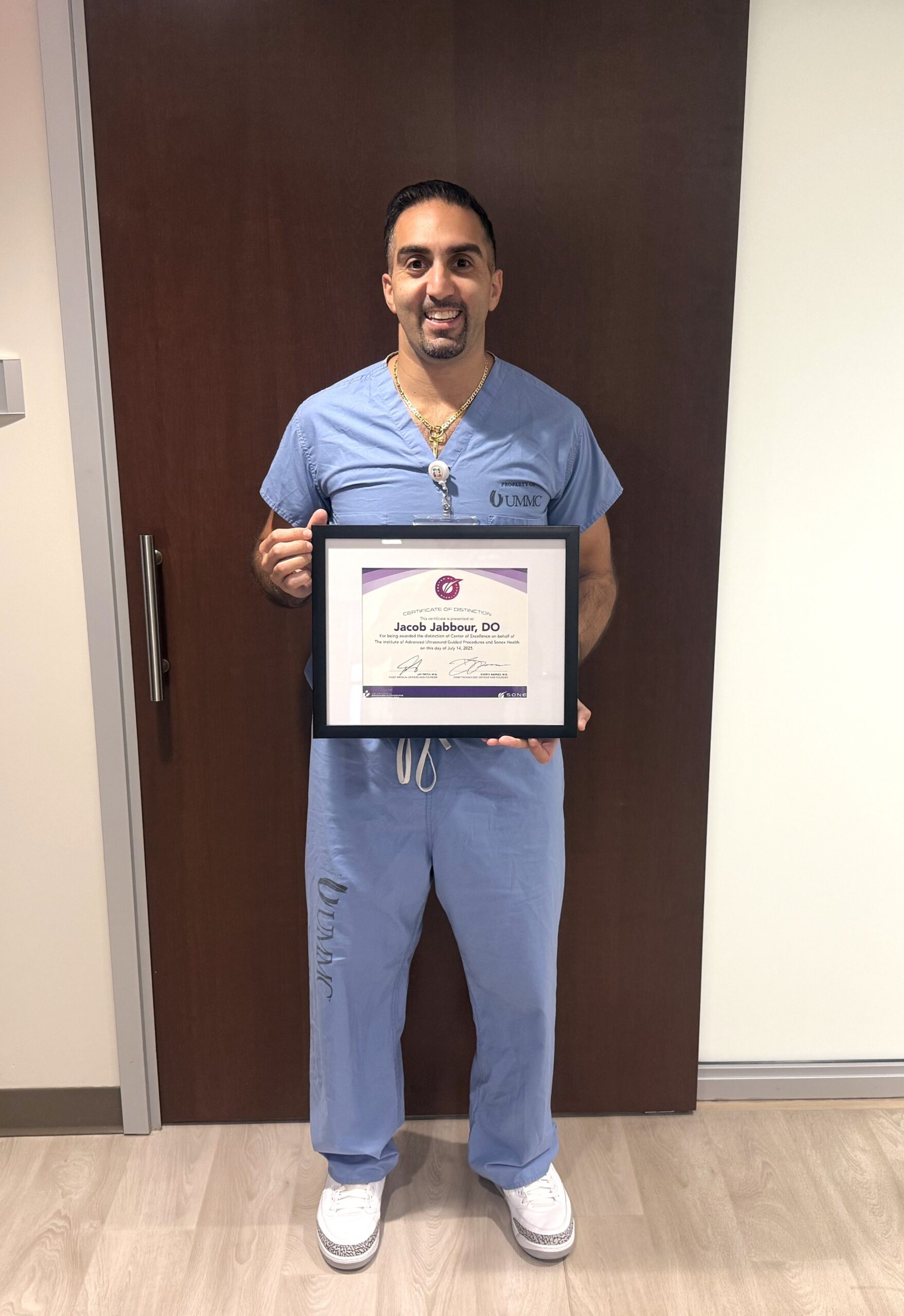
Creating a Practice Patients Trust
To Dr. Jacob Jabbour, patient safety and positive patient experience are his top priorities. That’s why in 2022 the Connecticut-based hand surgeon became the first clinician in the area to offer trigger finger release (TFR) with ultrasound guidance using Sonex Health’s UltraGuideTFR™ technology. It went so well that the following year, he added a complementary technology – UltraGuideCTR™ for his patients who need carpal tunnel release (CTR) procedures.
“We have had such a low complication rate with these procedures,” says Dr. Jabbour. “And they’re as effective or more effective than the traditional surgical approaches because patients have an absolutely quicker recovery, less pain, and they’re really thrilled with their outcomes.”
No Operating Rooms
Dr. Jabbour notes that the biggest change for him with these technologies is that he can perform the procedures in his office rather than in an operating room. “This has removed the scheduling issues and limitations of offsite operating rooms and has allowed me to bring the procedures into an office space with familiar faces I work with every day.”
And since these CTR and TFR procedures are done using only local anesthesia, patients typically can drive themselves to and from his office. They also can stay in their street clothes, and don’t have to fast from food or medicines on the day of the procedure.
Diagnosis Made Easier
In the past, Dr. Jabbour diagnosed patients using an electromyography (EMG) test and had to use simulated models to show them what was happening with their hands and wrists. With ultrasound guidance, he can now, in real time, show his patients where the nerve is being compressed as well as explain how the procedure works and what to expect. “When patients have more comfort with the diagnosis, they have more comfort in proceeding with the treatment we’re offering.”
For trigger finger patients, Dr. Jabbour offers only ultrasound-guided procedures using UltraGuideTFR technology rather than the traditional surgical release. And, if needed, he often treats several fingers at once, giving his patients a “one and done” experience. “The great thing about TFR is that you can confirm right away that it’s cured,” he says.
For those with carpal tunnel syndrome, he typically offers the less-invasive ultrasound-guided procedure to those patients who are looking for a treatment option that allows them to get back to their lives quickly. Following carpal tunnel release with real-time ultrasound guidance (CTR-US), Dr. Jabbour reports his patients doing well and being satisfied with their scar and healing journey.
Making a Difference
Thinking about the hundreds of patients he has helped, several stand out. Dr. Jabbour says “I’m really happy to be able to help a mom sleep better, use her hands, and drive the kids to school without issues. I also had an 85-year-old patient recently who really just wanted to knit but didn’t want to go to an operating room or be put under general anesthesia. Now, she can use her hands without pain,” says Dr. Jabbour, adding, “I’m also proud we could help a patient who was getting terrible pain in his left arm during kidney dialysis that made his carpal tunnel symptoms worse. We were able to perform a CTR using UltraGuideCTR, and now he can go to his dialysis appointments without this discomfort.”
Center of Excellence
This dedication to better patient outcomes is why Dr. Jabbour was recently named a Center of Excellence (COE) physician by The Institute of Advanced Ultrasound Guided Procedures and Sonex Health. He says the recognition is both humbling and much appreciated. “It’s a confirmation that we can offer these procedures safely and effectively and have made ours a practice that patients and referring physicians can trust.”
Learn more about The Institute of Advanced Ultrasound Guided Procedures and our training programs to begin your MSK ultrasound training today.
Related Articles:
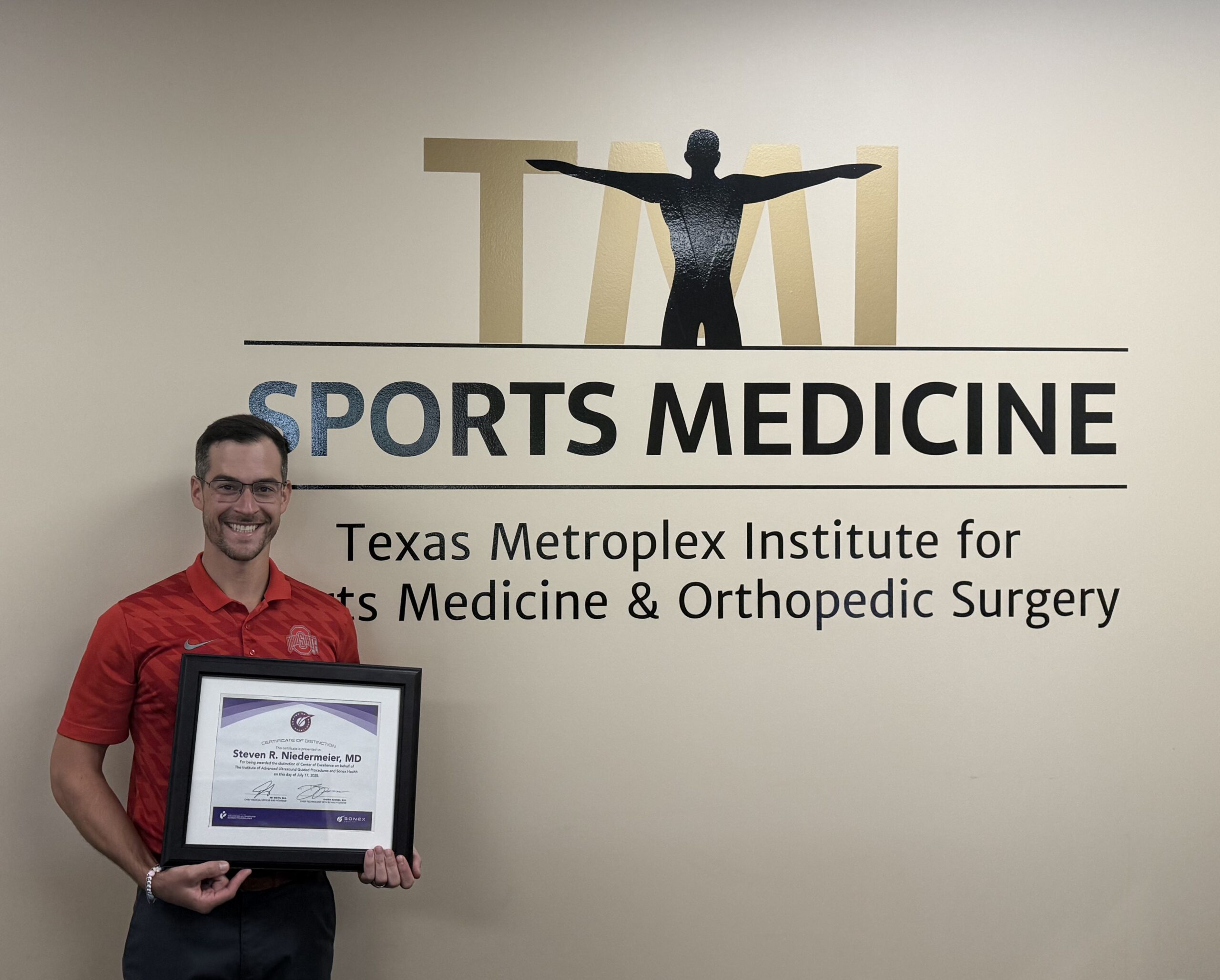
Quickly Returning Patients to Their Lives and Livelihoods
As a hand surgeon who is also a team physician for the Texas Rangers baseball club and the Dallas Stars hockey team, Dr. Steven Niedermeier knows the importance of quickly returning his patients — including those who are not professional athletes — to their lives and livelihoods after a procedure. That’s why, about three years ago, he began offering carpal tunnel release (CTR) with real-time ultrasound guidance, and more recently, he began offering trigger finger release (TFR) using similar technology.
Switching to this approach has been a game-changer for his patients. “To put it simply, my patients’ quality of life preoperatively, intraoperatively, and postoperatively is much better,” he says. “By incorporating Sonex Health’s UltraGuideCTR™ and UltraGuideTFR™ technologies into my practice, I’m offering techniques that are minimally invasive, allow patients to be wide awake during the procedure, and gets them back quickly to doing the things they love.”
Increased Patient Volume and Efficiency
Ultrasound guidance has been a game-changer for his practice as well. “It has vastly increased the number of patients I am able to see and treat. I used to have to send patients out for a painful electromyography (EMG) test before I could even talk about carpal tunnel treatment. Now, I can see the nerve, diagnose it, diagnose severity, and talk about treatment options in the same appointment.”
He says patient satisfaction and confidence in his care is also greater because patients can see the anatomy and better understand what’s involved in carpal tunnel release or trigger finger release, both with ultrasound guidance, during that first appointment. And that satisfaction, both pre-and post-procedure, has led to several referrals from patients he’s been able to help.
Screening Events
And to further spread word about this approach, Dr. Niedermeier has been offering free ultrasound screening and patient educational open houses and free screening events. “So many patients are sitting on the sidelines just suffering from carpal tunnel syndrome. They don’t want to make an appointment, or bear the cost of a diagnosis, yet they’re losing sleep and suffering,” he explains. “For me, these screenings are a way to educate them without them having to make an appointment or commit to anything.”
And if attendance is any indicator, demand is out there. Dozens of people have shown up to each of his events, so Dr. Niedermeier has had to open other time slots for these educational events to accommodate them.
Training has Been Key
Dr. Niedermeier credits a lot of his ultrasound success to the training and support he has received from Sonex Health, including their MSK Ultrasound Mini-Fellowship Training Programs. “The biggest apprehension is the fear of doing something new and also the time investment in learning,” he explains. “Yes, it takes time to learn a new modality, but if it hones your skills, increases your confidence, and increases your ability to help more patients afterward, it’s well worth it.”
Congratulations to Dr. Niedermeier
His dedication to continuous learning, and to providing excellent outcomes for his patients is why Dr. Niedermeier recently was named a Center of Excellence (COE) physician by The Institute of Advanced Ultrasound Guided Procedures and Sonex Health.
Says Dr. Niedermeier: “I’m an orthopedic surgeon because I chose a career that makes patients better. The validation for taking that leap of faith to do what’s right for my patients is probably what I love most about this COE designation.”
Learn more about The Institute of Advanced Ultrasound Guided Procedures and our training programs to begin your MSK ultrasound training today.
Related Articles:
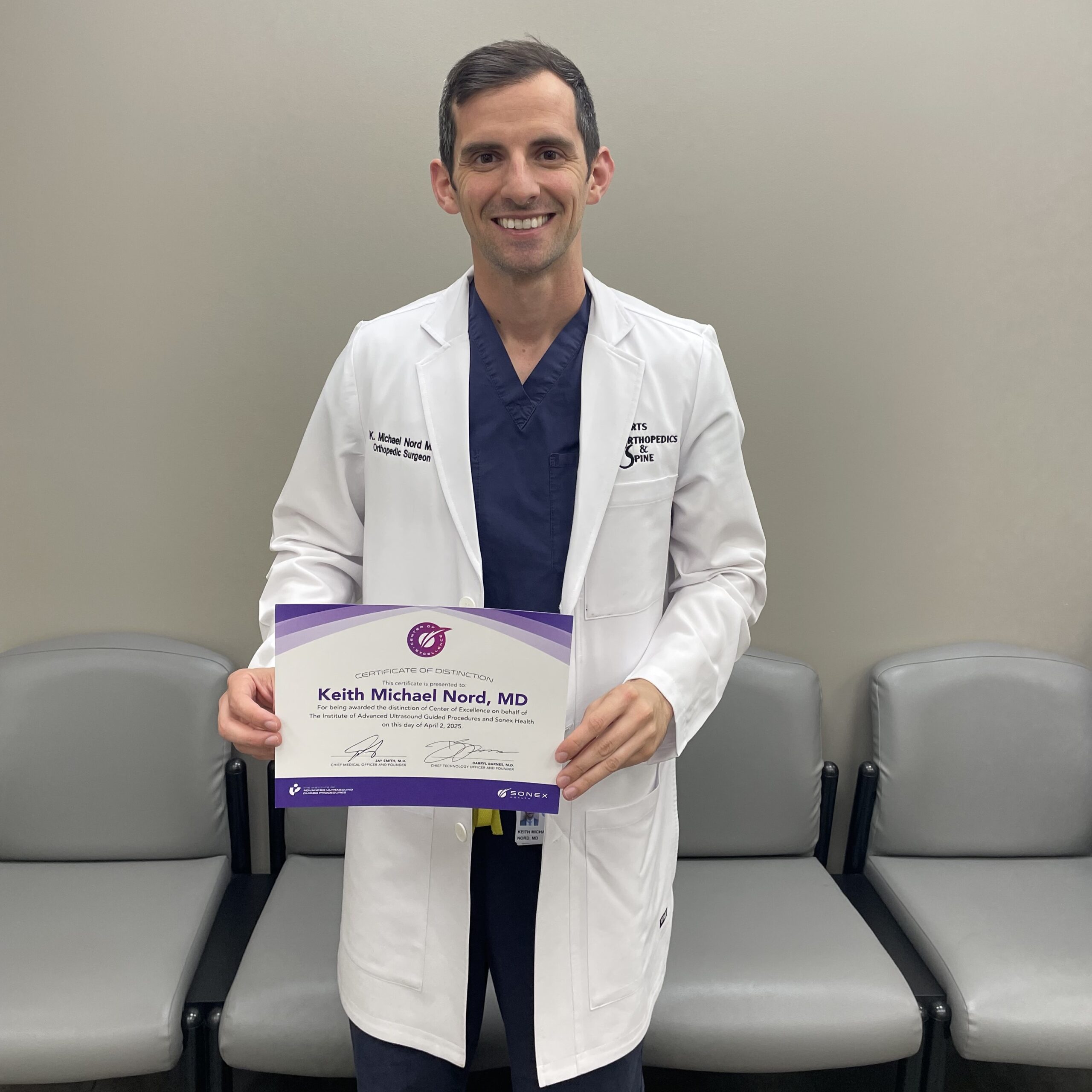
His Patients are Coming from Far and Near
When patients are willing to drive a long way to see you, you know you must be doing something right. Dr. Keith M. Nord is an orthopedic hand surgeon based in rural Jackson, Tennessee. Since transitioning from performing mini open and endoscopic carpal tunnel release (CTR) surgeries to becoming the only surgeon in the area performing CTR using real-time ultrasound guidance, his procedural volume has skyrocketed. So much so that he has had to open up another half-day at the surgery center.
“I’m about two hours from Nashville and an hour and a half from Memphis. Patients usually go from rural areas to the big city for medical procedures, but my patients are going the opposite direction because this ultrasound-guided procedure is in such demand,” says Dr. Nord. “Without a doubt, carpal tunnel release with Sonex Health’s UltraGuideCTR™ has been a practice-building event.”
Ultrasound was Always Compelling
Dr. Nord says he has always been interested in ultrasound. During his residency, he’d explore the ultrasound machine the anesthesiologist used to perform nerve blocks. “I’d look at the rotator cuff on a shoulder and do a shoulder scope just to see what I could pick up from that. By the time I did my fellowship, I became the ‘go-to guy’ for ultrasound. I’d get calls from other surgical staff to come and quickly check something for them,” recalls Dr. Nord.
That’s why he was so intrigued when hearing about CTR using real-time ultrasound guidance (CTR-US). He visited Sonex Health’s website, filled out a contact form, and heard back right away. He says the training and support provided by Sonex Health has been nothing short of incredible.
Now, two years later, Dr. Nord has performed more than 200 CTR-US procedures and has recently begun offering trigger release with Sonex Health’s UltraGuideTFR™ device, also using real-time ultrasound guidance. He is thrilled with the fast recovery these minimally invasive approaches bring for his patients.
Faster Recovery
“There are a lot of patients who have been putting off carpal tunnel surgery,” he says. “They’re suffering with it, waking up every night, but they just don’t have the means or time it takes to recover from traditional surgery. With ultrasound, they now have an option that lets them get back to work much quicker.”
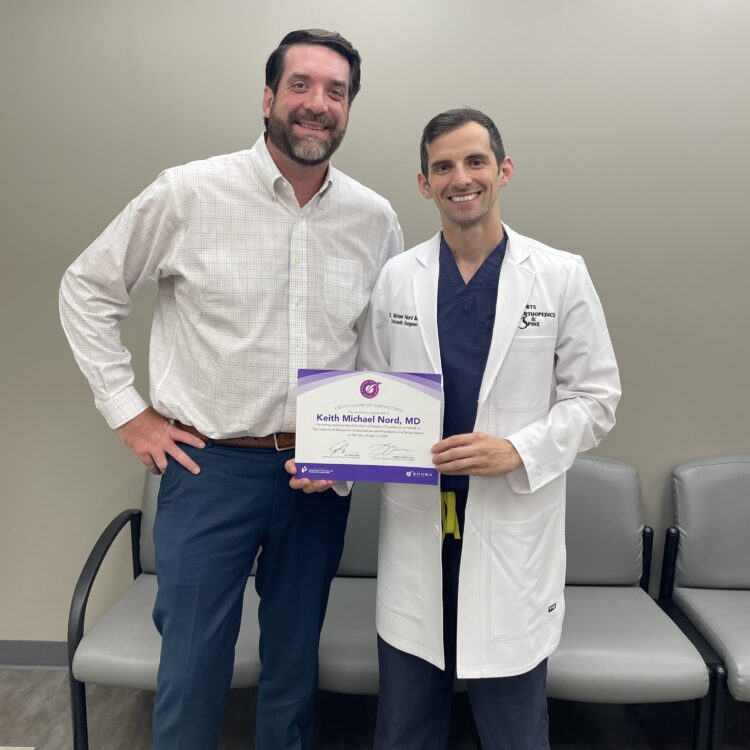
He says the other benefit is that this approach does not typically require sutures. “I just place a Steri-Strip and tell patients to keep the area clean.”
Dr. Nord recalls a patient who drove from Nashville to receive CTR with ultrasound guidance on both hands. “He is an electrophysiologist, so he was very well read on this procedure and was eager to have it done. He had simultaneous bilateral carpal tunnel releases and then tiled his bathroom three days later and was able to return to work immediately.”
Congratulations to Dr. Nord
Dr. Nord’s dedication to providing the best patient outcomes is why he has recently been named a Center of Excellence physician by The Institute of Advanced Ultrasound Guided Procedures and Sonex Health— a distinction that brings him great pride.
“I’m just so proud of our group and our practice for supporting me in this endeavor in bringing this technology to Tennessee. It’s so rewarding for my staff knowing we are doing good things for patients.”
Learn more about The Institute of Advanced Ultrasound Guided Procedures and our training programs to begin your MSK ultrasound training today.
Related Articles:
Dr. Craig Chappell honored by The Institute of Advanced Ultrasound Guided Procedures as a Center of Excellence Physician for Carpal Tunnel Release using Ultrasound Guidance
The Institute of Advanced Ultrasound Guided Procedures has named Dr. Craig Chappell of In2It Medical in Pleasant Grove, Utah a national Center of Excellence Physician for carpal tunnel release (CTR) using UltraGuideCTR™ and real-time ultrasound guidance.
“Our clinic specializes in technologies that provide our patients with an optimal experience,” says Dr. Chappell. “This technique allows us to take special care to avoid common complications that can be associated with carpal tunnel release.”
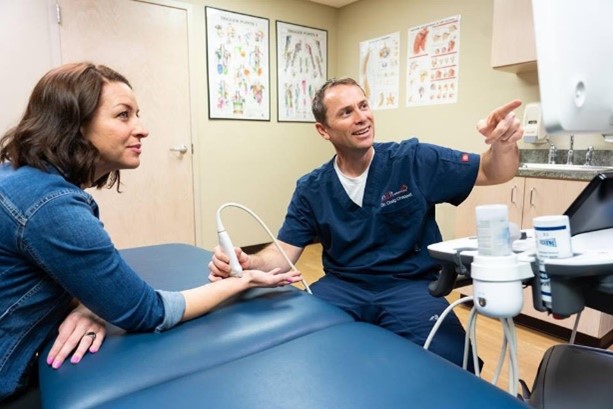
Since 2018, Dr. Chappell has performed more than 500 carpal tunnel release procedures with ultrasound guidance, helping patients resume normal activities in much shorter time than with traditional CTR approaches.
The technique, which involves one small wrist incision, typically uses a bandage rather than sutures to close the incision and over-the-counter pain medication, such as Ibuprophen, is usually all that is needed to manage post-operative pain. Most patients can return to work and normal activities within 3–6 days.
Dr. Chappell says his patients appreciate that no general anesthesia is required and that they can return to work faster using this technique. He performs most of his procedures on a Thursday so his patients — even those who do manual labor — have the opportunity to return to work on the following Monday.
“Dr. Chappell is dedicated to helping his patients get back to their busy lives by offering procedures that reduce downtime and improve function.”
Dr. Jay Smith, Chief Medical Officer at Sonex Health and The Institute of Advanced Ultrasound Guided Procedures
“Dr. Chappell is dedicated to helping his patients get back to their busy lives by offering procedures that reduce downtime and improve function. His steadfast commitment to his patients and his clinic’s philosophy of a personalized and transformative approach to healing is why Dr. Chappell is a Center of Excellence Physician,” says Dr. Jay Smith, Chief Medical Officer at Sonex Health and The Institute of Advanced Ultrasound Guided Procedures.
An estimated 13 million adults in the United States1 suffer from carpal tunnel syndrome (CTS), a nerve disorder that causes numbness, tingling, and pain in the hands and fingers. Left untreated, CTS can cause long-term damage and debilitation.
It has been estimated that more than 2.7 million CTS patients are indicated for carpal tunnel release surgery2, yet only 580,000 procedures are performed each year3. The most common reasons for declining CTR surgery are fear of the surgery and concerns about recovery time.4,5 Providing a solution that can address these concerns will help to close the treatment gap and improve patients’ quality of life.
About Dr. Craig Chappell
Craig Chappell, DO, is a board certified neuromusculoskeletal medicine specialist in Pleasant Grove, Utah, specializing in interventional orthopedics and regenerative medicine. He attended Pikeville College School of Osteopathic Medicine in Pikeville, Ky; interned at Berkshire Medical Center in Pittsfield, Mass.; and served his family practice residency at O’Bleness Memorial Hospital in Athens, Ohio. He also served a fellowship in sports medicine at Lake Erie College of Osteopathic Medicine and a fellowship in neuromusculoskeletal/osteopathic manual medicine at O’Bleness Memorial Hospital. Dr. Chappell has also earned certifications in sports medicine (CAQSM) and in musculoskeletal sonography (RMSK).
###
ABOUT SONEX HEALTH
Founded in 2014, Sonex Health’s mission is to be the world leader in ultrasound guided surgery by delivering physicians innovative therapies that reduce invasiveness, improve safety, and reduce the cost of care. With a strong focus on entrapment neuropathy, Sonex Health’s first proprietary technology — developed by Dr. Darryl E. Barnes and Dr. Jay Smith at the world-renowned Mayo Clinic — is UltraGuideCTR (formerly referred to as SX-One Micro-Knife), which may be utilized with or without ultrasound guidance to perform carpal tunnel release. Sonex Health’s second proprietary technology is UltraGuideTFR, for the treatment of trigger finger, also known as stenosis tenosynovitis.
ABOUT THE INSTITUTE OF ADVANCED ULTRASOUND GUIDED PROCEDURES
Founded in 2018 to support the Sonex Health mission and clinical excellence, The Institute of Advanced Ultrasound Guided Procedures is focused on innovation supported by robust clinical research, and world-class professional education and training that transforms the treatment experience for patients, providers and payers.
References:
1. Papanicolaou GD, et al. The prevalence and characteristics of nerve compression syndromes in the general population. J Hand Surg 2001;26A:460-6.
2. Atroshi I, et al. Severe carpal tunnel syndrome potentially needing surgical treatment in a general population. J Hand Surg 2003;28A:649-44.
3. Fajardo M, et al. Incidence of carpal tunnel release: trends and implications with the United States ambulatory care setting. J Hand Surg 2012;37A:1599-1605.
4. Gong HS, Baek GH, Oh JH, Lee YH, Jeon SH, Chung MS. Factors affecting willingness to undergo carpal tunnel release. JBJS. 2009;91(9):2130-2136.
5. Sonex Health Market Research “Why not Undergo CTR?”
Eagan, Minn., March 25, 2022 — Sonex Health and the Institute of Advanced Ultrasound Guided Procedures announced the publication of the results of a multicenter study reporting that carpal tunnel release (CTR) using UltraGuideCTR with real-time ultrasound guidance demonstrated clinically meaningful improvements in symptoms and function, rapid return to normal activities, and minimal work absenteeism in real-world clinical practice.
The peer-reviewed article, “Multicenter pragmatic study of carpal tunnel release with ultrasound guidance,” was published in the March issue of Expert Review of Medical Devices. The study reported the results of a heterogenous group of 373 carpal tunnel syndrome (CTS) patients (427 hands, mean age 55 years, 71% female) who underwent CTR using UltraGuideCTR with real-time ultrasound guidance at 24 clinics in the United States. Nearly 90 percent of procedures were performed using only local anesthesia.
Data were collected from a real-world registry, Assessment of the Patient Experience – Carpal Tunnel Release (APEX-CTR), established by the Institute of Advanced Ultrasound Guided Procedures and Sonex Health in 2019 following the commercial launch of Sonex Health’s UltraGuideCTR device (formerly SX-One MicroKnife®).
Study authors, John Fowler, MD of the University of Pittsburgh Medical Center, Kevin Chung, MD of the University of Michigan Comprehensive Hand Center, and Larry Miller, PhD of the Department of Biostatistics at Miller Scientific, analyzed patient-reported outcomes daily for up to two weeks and, also one, three and six months post-CTR, using the validated CTS symptom and functional assessment instruments Quick Disabilities of the Arm, Shoulder and Hand (QuickDASH or QDASH) and Boston Carpal Tunnel Questionnaire (BCTQ), as well as return to normal activities, return to work, and patient satisfaction.
Highlights of the study results:
- The median time to return to activities was three days and return to work five days, suggesting a favorable time to return to normal activities and work when compared to the published results of open/mini-open CTR procedures
- Compared to baseline, there were significant decreases in QDASH, BCTQ-SSS (Symptom Severity Scale) and BCTQ-FSS (Functional Status Scale) scores at two weeks, three and six months (all p<0.001)
- Nearly 15% of procedures were simultaneous bilateral CTRs, shortening the overall episode of care for patients with significant bilateral disease and suggesting the potential for cost savings to the healthcare system
- No major neurovascular complications were reported
Dr. Paul Paterson – Orthopedic hand surgeon
“This is the largest study published on CTR using ultrasound guidance to report return-to-activity and return-to-work data.”
“My patients treated with CTR-US reported clinically meaningful improvements in symptoms and function,” said Paul Paterson, MD orthopedic hand and upper extremity surgeon in Buffalo, N.Y.
“This is the largest study published on CTR using ultrasound guidance to report return-to-activity and return-to-work data.”
Matthew Kirsch, MD orthopedic surgeon in Rochester, Minn. adds, “This study confirms that a patient undergoing this type of procedure can more quickly return to their activities, which can have a significant positive effect on their overall satisfaction and quality of life.”
More data to come
This recent multicenter study is the eighth peer-reviewed publication reporting the clinical results on CTR-US utilizing the UltraGuideCTR device with ultrasound guidance, totaling 521 patients and 651 wrists at up to 2.5 years post-CTR.
This year, the Institute of Advanced Ultrasound Guided Procedures plans to initiate two prospective clinical studies to further explore the benefits of CTR-US:
- A multicenter, prospective randomized controlled trial (RCT) comparing CTR-US using real-time ultrasound guidance to traditional OCTR/mOCTR – the first RCT for CTR-US in the United States
- A multicenter, prospective study to examine recovery time, effectiveness, and safety in subjects suffering from CTS who are treated with CTR-US using real-time ultrasound guidance in a procedure room
“Our published data, and the upcoming clinical studies we plan to execute over the next several months, exemplify our commitment to continue building a robust and compelling outcomes dataset to further demonstrate the safety and efficacy of UltraGuideCTR,” said Sonex Health CEO, Bob Paulson. “We look forward to sharing the findings.”
###
ABOUT SONEX HEALTH
Founded in 2014, Sonex Health’s mission is to be the world leader in ultrasound guided surgery by delivering physicians innovative therapies that reduce invasiveness, improve safety, and reduce the cost of care.
With a strong focus on entrapment neuropathy, Sonex Health’s first proprietary technology — developed by Darryl E. Barnes, MD and Jay Smith, MD at the world-renowned Mayo Clinic — is UltraGuideCTR (formerly referred to as SX-One Micro-Knife), which may be utilized with or without ultrasound guidance to perform carpal tunnel release. Sonex Health’s second proprietary technology is UltraGuideTFR, for the treatment of trigger finger, also known as stenosis tenosynovitis.
For information about Sonex Health, UltraGuideCTR, and UltraGuideTFR please visit www.sonexhealth.com.
ABOUT THE INSTITUTE OF ADVANCED ULTRASOUND GUIDED PROCEDURES
Founded in 2018 to support the Sonex Health mission and clinical excellence, the Institute of Advanced Ultrasound Guided Procedures is focused on innovation supported by robust clinical research, as well as world-class professional education and training that transforms the treatment experience for patients, providers and payers.
